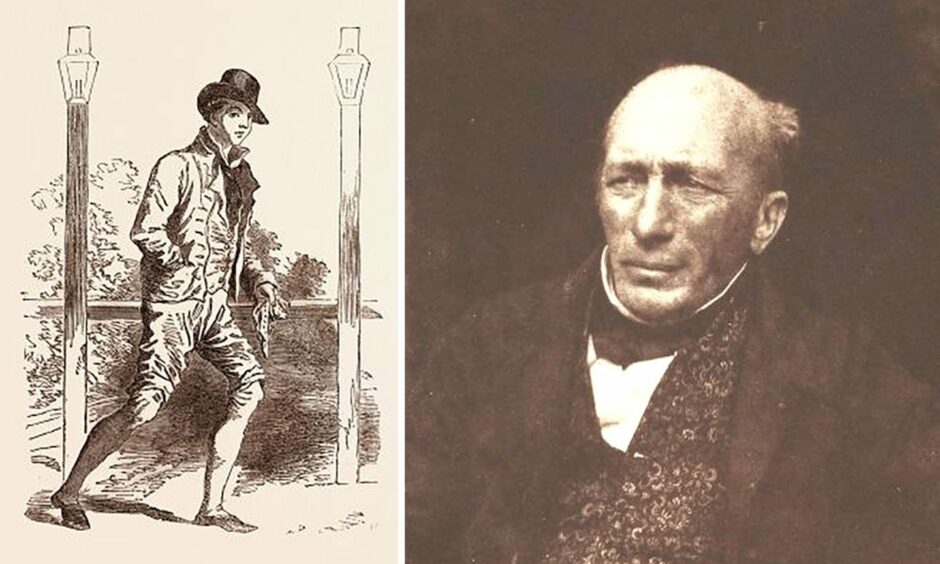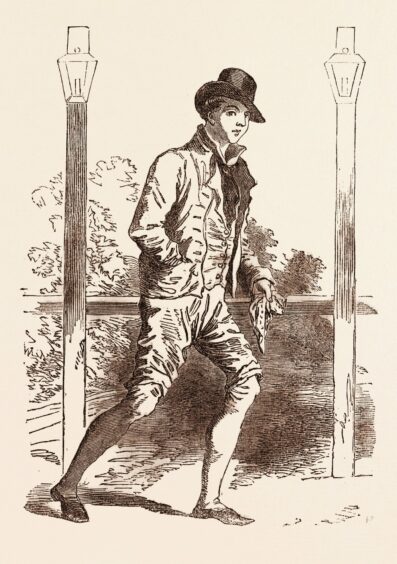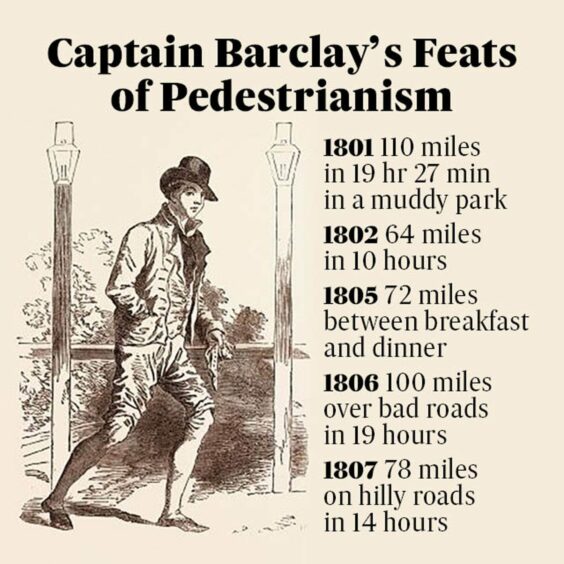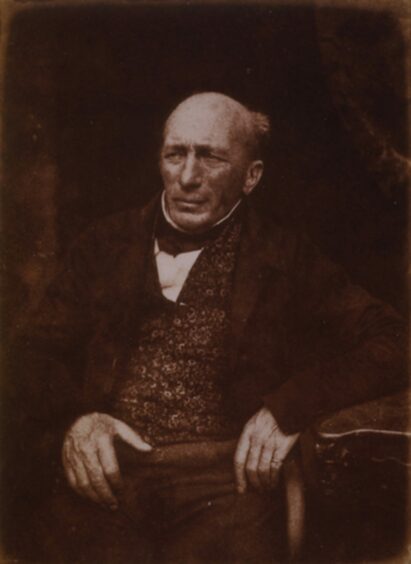
Here’s a challenge to tackle that lingering festive flab: find a measured mile, somewhere like a race course.
Walk 1,000 miles over 1,000 hours (that’s six weeks) stopping only for short snatches of sleep.
Complete successfully, and pocket £100,000.
Nobody’s that crazy, surely?
In 1809 they were, or at least one Captain Robert Barclay Allardice, originally of Stonehaven, was.
Famous strength of Clan Barclay
Ever since the English Civil War, the Clan Barclay had a reputation for being immensely strong, wrestling bulls, carrying flour sacks with their teeth, uprooting trees, hurling donkeys, so legend has it.
Robert (1779- 1854) was an athlete par excellence, breaking records in everything from walking and running to boxing and weightlifting.
Add to that his prodigious entrepreneurial talent and ingenuity and vision as a farmer and public transport investor, and Captain Barclay Allardice’s life takes on almost legendary proportions.
His father was Robert Barclay, 5th Laird of Ury, MP for Kincardineshire from 1788.
His first wife died in childbirth, and Barclay went on to bring a veneer of ancient royalty to the family by marrying Sarah Ann Allardice, a descendant of Robert II of Scotland and of the Earls of Airth, Menteith and Strathearn.
In recognition of the nobility of his wife’s family, Robert Barclay thenceforth took the surname of Allardice.
His athlete son Captain Robert Barclay Allardice came from this marriage.
Despite the family’s nobility, as heir to the estate, Robert found himself virtually penniless when his father died.
Robert Barclay Allardice: Rough, tough and revered
Perhaps it was this misfortune that made him one of the roughest, toughest men of his generation, determined to make his mark in the brutal world of professional sport, where bets could run into hundreds of thousands.
With his bulldog at heel, the young Barclay-Allardice was a revered and sometimes feared figure in the London taverns where he was never backward at coming forward to accept challenges to his strength, running talent, bare-knuckle boxing.
An average day for him on his estate would go something like this: Rise at 5 am, walk 30 miles while grouse shooting, walk home in 11 hours. After that, dinner, before walking 16 miles to a ball, home at 7 am and straight back to grouse-shooting.
By 1805 he’d made a nationwide name for himself as a marathon walker, sprinter and prize-fighter, four years later pulling off what everyone agrees was his most astonishing feat.
Walking 1,000 miles over 1,000 hours
Between 1 June and 12 July 1809 at Newmarket, he walked 1 mile in each of 1000 successive hours to win an initial wager of 1000 guineas.
The exploit attracted considerable interest including from the great and the good of the land, with bets totalling £100,000 until it became clear that he’d breeze through the challenge, when wagers were stopped.
The Times reported that “he performed his last mile in the quarter of an hour after three, with perfect ease and great spirit, amidst an immense concourse of spectators.
“Not a bed could be procured on Tuesday night at Newmarket, Cambridge, or any of the towns and villages in the vicinity, and every horse and every species of vehicle was engaged.”
Taking the opportunity to rig bets
During the 1000 days, his time per mile increased from 14m 54s to 21m 4s and his weight dropped from 13st 4lb to 11st, despite Robert wolfing down mountains of steaks, mutton chops, roast fowl, porter and wine.
“He said that during the first night after his walk he would have himself awoke twice or thrice, to avoid the danger of a too sudden transition from almost constant exertion to a state of long repose,” reported The Times.
It’s thought he gamed the betting system with tactics like wagering 1000 guineas that he could walk 90 miles in 21 hours. Then he apparently caught a cold and lost the bet.
He then increased the wager to 2000 guineas, which he lost again.
On his third try, the wager had grown to 5000 guineas, which he won with an hour to spare.
Using experience to aid scientific training
Barclay-Allardice brought science to his training methods, becoming the country’s leading expert in the preparation of athletes.
He turned the old mansion house at Ury into something like the world’s first sports training camp, much to the raised eyebrows of the good folk of Stonehaven.
Meanwhile he saw action twice against Napoleon’s forces as a soldier for the 23rd Regiment of Foot in 1805 and then with the Marquess of Huntly’s regiment of Gordon Highlanders.
During a failed campaign at Walcheren in the Netherlands in 1809 he witnessed the death of hundreds of Highlanders from swamp fever.
On his retirement from active service, Barclay-Allardice turned to his estate and again applied scientific methods to his farming.
From pedestrian to pedigree cattle farmer
He was the first in Scotland to set up a pedigree Shorthorn herd, for which he became renowned.
His passion for covering long distances on foot led to a passion for public transport, which at the time amounted to stagecoaches, including the Defiance from Arbroath into which he invested heavily.
On one occasion, Barclay-Allardice took over as guest coachman, running it at a dizzying speed, racing a hare at North Water Bridge and managing to overturn the coach at North Port Distillery, fortunately with no injuries.
Later in his life, there was a stooshie about his inherited titles.
The only creature to get the better of him turned out to be a horse.”
He claimed the Earldom of Airth, his lawyers claiming that this title could be inherited through the female line.
The claim was rejected by the House of Lords in 1839.
A similar claim to the Earldoms of Menteith and Stathearn was not pursued.
If it had been, it would have implied that Captain Barclay was the rightful King of Scotland.
In the end, the only creature to get the better of him turned out to be a horse. He took a bad kick in 1854, and died paralysed several days later.













Conversation